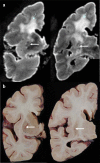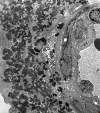Genetics of Vascular Dementia
Abstract
Genetic studies are transforming the way we diagnose, evaluate and treat patients. The era of genome-wide association studies promised to discover common risk variants in heterogeneous disorders where previous small-scale association studies had on the whole failed. However, as we enter the post-association era a degree of disappoint is felt regarding the lack of risk factors with large effect for a number of disorders including vascular disease. Vascular disorders are sporadic by nature, though a familial component has been observed. This review will focus on vascular dementia, the genetic risk factors for vascular disorders and highlight how new technologies may overcome the limitations of genome-wide association and nominate those genes that influence disease risk.
Figures




Similar articles
-
Best Linear Unbiased Prediction of Individual Polygenic Susceptibility to Sporadic Vascular Dementia.J Alzheimers Dis. 2016 May 31;53(3):1115-9. doi: 10.3233/JAD-160391. J Alzheimers Dis. 2016. PMID: 27258425
-
Association studies of sporadic Parkinson's disease in the genomic era.Curr Genomics. 2014 Feb;15(1):2-10. doi: 10.2174/1389202914666131210212745. Curr Genomics. 2014. PMID: 24653658 Free PMC article.
-
The genetics of breast cancer risk in the post-genome era: thoughts on study design to move past BRCA and towards clinical relevance.Breast Cancer Res. 2016 Oct 3;18(1):99. doi: 10.1186/s13058-016-0759-4. Breast Cancer Res. 2016. PMID: 27716388 Free PMC article. Review.
-
Genetics of Alzheimer's disease.Adv Genet. 2014;87:245-94. doi: 10.1016/B978-0-12-800149-3.00005-6. Adv Genet. 2014. PMID: 25311924 Review.
-
New technologies provide insights into genetic basis of psychiatric disorders and explain their co-morbidity.Psychiatr Danub. 2010 Jun;22(2):190-2. Psychiatr Danub. 2010. PMID: 20562745 Review.
Cited by
-
Genome‑wide DNA methylation profiling in a rat model with vascular dementia.Mol Med Rep. 2018 Jul;18(1):123-130. doi: 10.3892/mmr.2018.8990. Epub 2018 May 8. Mol Med Rep. 2018. PMID: 29749552 Free PMC article.
References
-
- Venter JC, Adams MD, Myers EW, et al. The sequence of the human genome. Science. 2001;291:1304–1351. - PubMed
-
- Lander ES, Linton LM, Birren B, et al. Initial sequencing and analysis of the human genome. Nature. 2001;409:860–921. - PubMed
-
- van Deventer SJ. Cytokine and cytokine receptor polymorphisms in infectious disease. Intensive Care Med. 2000;26(Suppl 1):S98–102. - PubMed
Grants and funding
LinkOut - more resources
Full Text Sources
